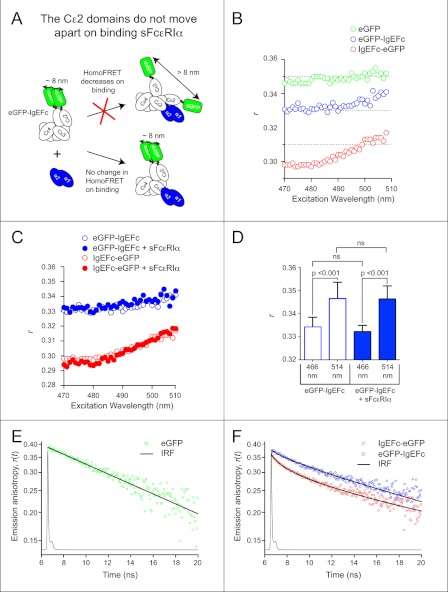FIGURE 3.
HomoFRET in eGFP-IgEFc and IgEFc-eGFP does not change on binding to sFcϵRIα. A, the schematic illustrates how homoFRET could be used to detect independent movements of polypeptide chains in the IgEFc homodimer on binding to sFcϵRIα. B, an anisotropy excitation scan of either eGFP alone (green circles), eGFP-IgEFc (blue circles), or IgEFc-eGFP (red circles) is shown. HomoFRET occurs in both constructs as shown by the significantly lower emission anisotropy (r) at lower excitation wavelengths and the increase in r with excitation wavelength. C, sFcϵRIα binding has no effect on the anisotropy excitation scans of either eGFP-IgEFc (blue circles) or IgEFc-eGFP (red circles). D, repeat measurements of steady-state anisotropies of eGFP-IgEFc at two wavelengths are shown. Data represent the average and S.D. for n = 9 independent measurements. Significant values were determined using a one-way analysis of variance with Tukey-Kramer test. The absence of any change on binding sFcϵRIα confirms that there is no significant change in orientation between the Cϵ2 domains. ns, not significant. E, a semi-log plot shows the anisotropy decay r(t) for eGFP alone, with raw data five-point-averaged for display purposes only (green circles). The fit line passing through the decay data is the best-fit impulse response for eGFP rotation (see the supplemental information for details). The overlaid line graph shows the instrument response function (IRF). The anisotropy decay of eGFP (in the absence of homoFRET) is monoexponential and thus appears linear in this semi-log plot. F, a semi-log plot shows the anisotropy decays for eGFP-IgEFc (blue circles) and IgEFc-eGFP (red circles). Raw data were five-point averaged for display purposes only with the lines passing through the data points being the theoretically calculated anisotropy decays based on the models (for a detailed description see supplemental information). The pronounced curvature of the decays in this semi-log plot demonstrate the expected deviation from monoexponential decay kinetics due to homoFRET.

